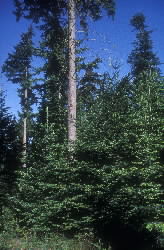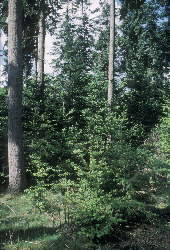Summary


Summary
The aim of this project is to develop flexible models of individual tree and stand growth for use in British forestry.
Existing growth and yield models in GB were explicitly developed for use in even-aged stands of a single species and cannot realistically be used to accurately predict the growth, yield and development of forest stands of mixed species and/or mixed ages. More flexible models are therefore needed to evaluate the impacts on stand growth and development of a wide range of silvicultural options that may be used as part of the ‘Changing Silviculture’ agenda within Britain.
An initial review of growth and yield models that could be applied to mixed-age and mixed-species stands identified the Austrian model MOSES (Hasenauer, 1994) as being the most suitable for evaluation under British conditions. Collaborative work with the scientists developing the model at the University of Natural Resources and Applied Life Sciences (BOKU), Vienna was started in April 2009.
From this collaboration MOSES_GB, a version of MOSES that includes a parameterisation of British-grown Sitka spruce, has been produced and is now undergoing testing.
Looking to the future, the project team’s vision is that MOSES_GB will become the model of choice that allows scientists and forest managers to examine the effects of silvicultural practices on growth and yield and on the development of stand structure, in uniform stands as well as stands of mixed age and mixed species.
MOSES GB has been developed collaboratively by:
- Catia Arcangeli (Project Leader, Forest Research, Alice Holt Research Station)
- Tom Jenkins (Head of Forest Research in Wales, Bangor)
- Sophie Hale (Forest Research, Northern Research Station)
- Hubert Hasenauer (Head of the Institute of Silviculture, BOKU)
- Mario Klopf (Institute of Silviculture, BOKU, until 2013)
- Christopher Thurnher (Institute of Silviculture, BOKU).
Contact
Catia Arcangeli (Project Leader, Forest Research, Alice Holt Research Station)
Hasenauer, H. (1994) Ein Einzelbaumwachstumssimulator für ungleichaltrige Fichten-Kiefern- und Buchen-Fichtenmischbestände. Österreichische Gesellschaft für Waldökosystemforschung und Experimentelle Baumforschung, Vienna, Austria, 152 pp.
A single-tree growth simulator for uneven spruce-pine and beech-spruce mixed stands. Austrian Society for Forest Ecosystem Research and Experimental Tree Research, Vienna, Austria, 152 pp [in German].
Forestry Commission policy
In all three countries the United Kingdom Woodland Assurance Scheme (UKWAS) requires forest managers to ‘increasingly favour’ continuous cover forestry (CCF) in wind firm conifer plantations and semi-natural woodland (UKWAS, 2000; sections 3.4.3 and 3.4.4). Greater use of CCF is also supported in the UK Forestry Standard of 2004 (e.g. Standard Note 4).
The Forestry Commission CCF Working Group has established National Network sites in each of the three countries and Forest Research researchers have been closely involved in the establishment and ongoing support of these woodlands.
The most recent discussions about the upcoming revision of Operational Guidance Booklet 7 (OGB 7) – Managing Continuous Cover Forests, have identified yield modelling and prediction in CCF stands as an area of increasing importance.
Funders and partners
![]()

This research is funded by the Forestry Commission Alternative management approaches programme and is being undertaken by staff in Forest Research’s Centre for Sustainable Forestry and Climate Change in collaboration with staff at the Department of Forest and Soil Sciences at the University of Natural Resources and Applied Life Sciences, Vienna (BOKU).
MOSES GB is based on the model originally developed by Professor Hubert Hasenauer of the Department of Forest and Soil Sciences at the University of Natural Resources and Applied Life Sciences, Vienna (BOKU).
The current version MOSES_GB has been developed collaboratively by staff in Forest Research and in the Department of Forest and Soil Sciences at BOKU.
